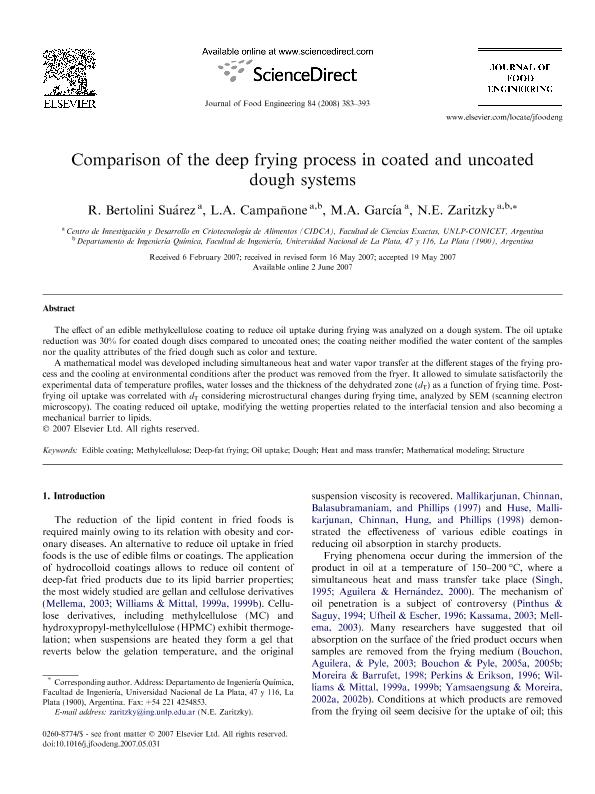Artículo
Comparison of the deep frying process in coated and uncoated dough systems.
Fecha de publicación:
02/2008
Editorial:
Elsevier
Revista:
Journal of Food Engineering
ISSN:
0260-8774
e-ISSN:
1873-5770
Idioma:
Inglés
Tipo de recurso:
Artículo publicado
Clasificación temática:
Resumen
The effect of an edible methylcellulose coating to reduce oil uptake during frying was analyzed on a dough system. The oil uptake reduction was 30% for coated dough discs compared to uncoated ones; the coating neither modified the water content of the samples nor the quality attributes of the fried dough such as color and texture. A mathematical model was developed including simultaneous heat and water vapor transfer at the different stages of the frying process and the cooling at environmental conditions after the product was removed from the fryer. It allowed to simulate satisfactorily the experimental data of temperature profiles, water losses and the thickness of the dehydrated zone (dT) as a function of frying time. Postfrying oil uptake was correlated with dT considering microstructural changes during frying time, analyzed by SEM (scanning electron microscopy). The coating reduced oil uptake, modifying the wetting properties related to the interfacial tension and also becoming a mechanical barrier to lipids. microscopy). The coating reduced oil uptake, modifying the wetting properties related to the interfacial tension and also becoming a mechanical barrier to lipids. oil uptake was correlated with dT considering microstructural changes during frying time, analyzed by SEM (scanning electron microscopy). The coating reduced oil uptake, modifying the wetting properties related to the interfacial tension and also becoming a mechanical barrier to lipids. microscopy). The coating reduced oil uptake, modifying the wetting properties related to the interfacial tension and also becoming a mechanical barrier to lipids. dT) as a function of frying time. Postfrying oil uptake was correlated with dT considering microstructural changes during frying time, analyzed by SEM (scanning electron microscopy). The coating reduced oil uptake, modifying the wetting properties related to the interfacial tension and also becoming a mechanical barrier to lipids. microscopy). The coating reduced oil uptake, modifying the wetting properties related to the interfacial tension and also becoming a mechanical barrier to lipids. dT considering microstructural changes during frying time, analyzed by SEM (scanning electron microscopy). The coating reduced oil uptake, modifying the wetting properties related to the interfacial tension and also becoming a mechanical barrier to lipids.
Palabras clave:
Deep frying
,
Coated dough
,
Methylcellulose
,
Mathematical model
Archivos asociados
Licencia
Identificadores
Colecciones
Articulos(CIDCA)
Articulos de CENTRO DE INV EN CRIOTECNOLOGIA DE ALIMENTOS (I)
Articulos de CENTRO DE INV EN CRIOTECNOLOGIA DE ALIMENTOS (I)
Citación
Bertolini Suárez, R.; Campañone, Laura Analia; Garcia, Maria Alejandra; Zaritzky, Noemi Elisabet; Comparison of the deep frying process in coated and uncoated dough systems.; Elsevier; Journal of Food Engineering; 84; 3; 2-2008; 383-393
Compartir
Altmétricas




